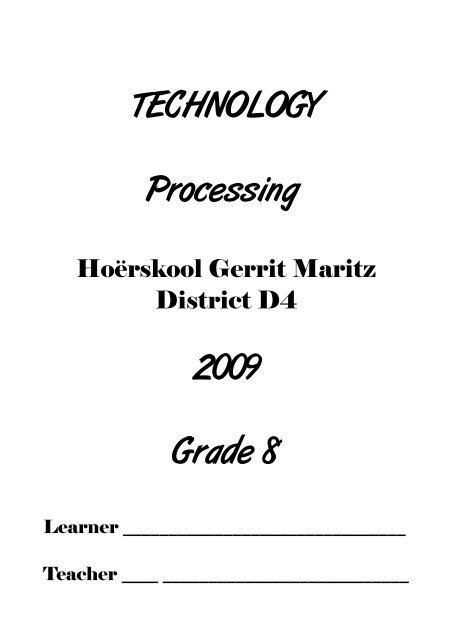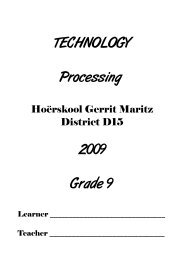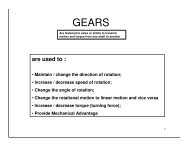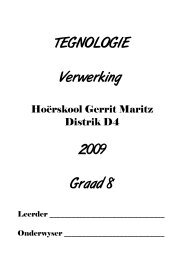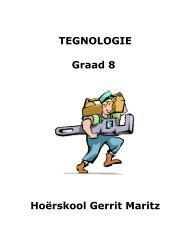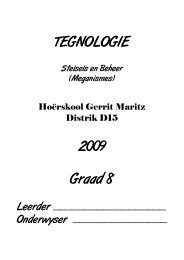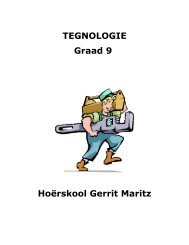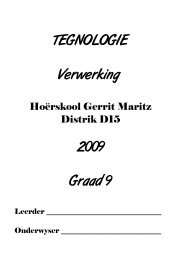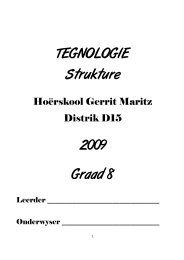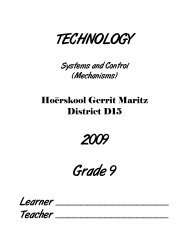TECHNOLOGY Processing 2009 Grade 8 - Tegnologie
TECHNOLOGY Processing 2009 Grade 8 - Tegnologie
TECHNOLOGY Processing 2009 Grade 8 - Tegnologie
Create successful ePaper yourself
Turn your PDF publications into a flip-book with our unique Google optimized e-Paper software.
<strong>TECHNOLOGY</strong><br />
<strong>Processing</strong><br />
Hoërskool Gerrit Maritz<br />
District D4<br />
<strong>2009</strong><br />
<strong>Grade</strong> 8<br />
Learner _______________________________<br />
Teacher ____ ___________________________
CAPABILITY TASK<br />
In this module you are going to make a portfolio file in which you can keep your Technology<br />
documents. You will use the knowledge you will obtain about materials and the processing<br />
thereof in order to comply with the given specifications.<br />
The portfolio file must:<br />
• be strong / resist forces<br />
• durable / last long<br />
• keep your portfolio document neat and dry<br />
• be at least 350 x 250 x 60 mm<br />
• be made of recycled paper / cardboard<br />
To help you with your capability task you will complete Resource Tasks and Case Studies.<br />
INVESTIGATE<br />
Since the earliest times people used different materials to make articles. Cothes were made of<br />
animal skins, hammers were made of sticks and stones. Over the ages people learnt how to<br />
process materials to fulfill certain needs. Bones and stones were sharpened against rough<br />
surfaces to make knives and needles. Textiles were woven from wool. The development of<br />
technology created thousands of processing possibilities. Nylon is one of the first sinthetic<br />
textiles which today has countless uses.<br />
We are going to investigate different materials and how it can be processed to enhance its<br />
properties or to adapt it for specific uses.<br />
Materials<br />
Materials can be natural or manmade. Natural materials come from plants, animals or<br />
minerals.<br />
Resource Task 1: Date: _______________________<br />
Place a checkmark in the correct columns to indicate where each material originates from.<br />
(Each material will have two checkmarks)<br />
plastic<br />
copper<br />
leather<br />
glass<br />
Material Natural Manmade Plant Animal Mineral<br />
pine wood<br />
chipboard<br />
rubber
wool<br />
Stainless steel<br />
fibre glass<br />
Aspect<br />
Resource Task 1<br />
Level 7<br />
(Mastered<br />
excellently)<br />
Assignments<br />
completed and<br />
correct. Obvious<br />
effort.<br />
Properties of materials<br />
Level 6<br />
(Meritoriously<br />
mastered )<br />
Level 5<br />
(Substantially<br />
mastered)<br />
Assignments<br />
completed and<br />
correct. Some<br />
effort.<br />
Assessment<br />
Level 4<br />
(Adequately<br />
mastered)<br />
Level 3<br />
(Moderately<br />
mastered)<br />
Assignments<br />
completed<br />
haphazardly.<br />
Hardly any effort.<br />
Level 2 (Elementary<br />
mastered)<br />
Level 1<br />
(Not mastered)<br />
Assignments incomplete.<br />
No effort.<br />
One of the most important questions that should be asked, before a product can be made, is<br />
what material will be used. Materials are chosen based on their properties and the purpose<br />
for which the product will be used. You would, for example not use paper to make an<br />
umbrella, since an umbrella must be water resistant..<br />
• Stiffness: how little distortion or deflection occurs when placed under pressure<br />
• Hardness: Ability to withstand being scratched cut or dented<br />
• Brittleness: When material fractures with little or no deformation<br />
• Toughness: Resistance to impact<br />
• Ductility: Allows a material to be elongated or stretched without breaking<br />
• Elasticity: can be stretched out of shape, but will return to original shape.<br />
• Flexibility: If a material bends easily and does not crack.<br />
• Plasticity: After pressing or squashing a material the shape changes permanently.<br />
• Absorbent: Materials that suck up water easily.<br />
• Waterproof: Materials that seems to push water away, it just runs of the material<br />
• Corrosion resistant: resists corrosion (rust) or UV-rays of the sun<br />
• Heat resistan: will not burn or acts an insulator against heat<br />
• Conducts electricity: lets electricity pass through it<br />
• Magnetic: is attracted by a magnet<br />
• Transparant: can see through it<br />
Types of materials<br />
Metals<br />
Ferrous metals contain iron which rust and is magnetic. Examples: steel, iron<br />
Non ferrous metals contain no iron, do not rust and is not magnetic. Examples: zinc,<br />
copper, silver<br />
When two or more metals are mixed it is called an alloy. Metals are alloyed to obtain properties<br />
which are absent from pure metals. Examples of alloys are; brass, a mixture of zinc and<br />
copper, stainless steel is a composition of carbon, chrome, nickel and magnesium. Bronze<br />
consists of copper and tin.<br />
Mark<br />
___<br />
10
Wood<br />
Timberwood is very expensive and since it is a natural resource we should not abuse it.<br />
There are plantations which are grown with the purpose of supplying wood for wood products<br />
and paper. At these plantations fast growing trees are planted.<br />
The terms hardwood and softwood do not refer to the wood, but to the leaves of the trees:<br />
Softwoods come from trees with needle-like leaves; the most common types are pine, spruce<br />
and larch. Hardwoods come from broad-leaved trees; they include oak, ash and beech from<br />
the temperate zones, and a wide variety of tropical hardwoods such as mahogany, meranti<br />
and jelutong. Not all hardwoods are hard - balsa is very soft.<br />
Manufactured board<br />
Manufactured board is made by glueing together layers of woodfibres of veneers. It is usually<br />
made with leftover wood and has mainly been developed for industrial use, since it is possible<br />
to make many similar sheets of baord.<br />
This type of wood is much cheaper than real wood, but because the appearance is not as<br />
attractive as the real thing, a veneer is often glued as a top layer.<br />
Types of manufactured board are: plywood, laminated board, chip board, softboard, fibre<br />
board and softboard.<br />
Composite materials<br />
When two or more materials with different properties are combined, they form a composite<br />
material. The different materials work together to create a new material, which has the<br />
propeties of both. The two materials can clearly be distinguished in the new composite<br />
material.<br />
Examples:<br />
Mud and straw bricks<br />
Humans have been using composite materials for a long time in order to build our dwellings.<br />
Some of the earliest forms of building were built of mud bricks. Mud bricks work well when<br />
they are being compressed (compression forces) but a cake of mud is easily broken if it is bent<br />
(bending forces). This is because the act of bending places a tension force on one edge.<br />
At the same time as the mud block buildings were being built other people were making straw<br />
dwellings. Straw has a great deal of tensile strength (resistance to pulling forces) but it is very<br />
weak when crumpled. These early builders realised was that if straw, which has a good tensile<br />
strength was embedded in a block of mud, which has good compressive strength and left to<br />
dry the resulting brick would resist both tearing and squeezing. These composite bricks made<br />
excellent building materials.<br />
Car tyres<br />
Modern tyres are constructed of layers, which may include rayon cloth, steel bands and nylon<br />
belts all set in a matrix (binder) of rubber.<br />
Concrete<br />
Concrete is made from small stones and gravel called aggregate, sharp sand and cement. The<br />
small stone and gravel (aggregate) is the reinforcement and the cement is the matrix that<br />
binds it together. Concrete has good strength under compression but it is weak in tension. It<br />
can be made stronger under tension by adding metal rods, wires, mesh or cables to the<br />
composite. The concrete is cast around the rods. This is called reinforced concrete.<br />
Veselglas<br />
Consists of two distinct materials, a fibres of glass (ceramic), which is the reinforcement and a<br />
polymer resin called polyester, which serves as the matrix. The polyester resin polymer alone<br />
is brittle and has a low strength but when fibres of glass are embedded in the polymer it<br />
becomes strong, tough, resilient and flexible. It becomes an ideal material to make boat hulls,<br />
swimming pool linings, car bodies, roofing and furniture.
Textiles<br />
Textiles have been used for clothes and shelters for hundreds of years. Much earlier animal<br />
skins and natural textiles like wool, cotton and silk were used. The development of technology<br />
has provided a great variety of manmade textiles for the modern day technologist. Examples<br />
are nylon, polyester, and acrylics.<br />
Textiles are made by weaving or knitting fibres together, sometimes it is only squashed<br />
together and is kept together by the friction between the fibres. Some fabrics consist of layers<br />
which are bonded together and covered with plastic layer to make it water resistant. Strength<br />
of fabrics depends on the weaving methods and the type of fibre used.<br />
Other properties which are of importance are flexibility, water resistance, ventilation, isolation<br />
against heat and cold, wind resistance, shrinking and stain resistance. The properties of<br />
fabrics especially the strength, stiffness and tear resistance depends on the direction in which<br />
the force is applied.<br />
Compare properties of natural and manmade textiles:<br />
Fabric Absorbtion<br />
Quick<br />
drying<br />
Warm/<br />
cool<br />
Burns<br />
easily<br />
Elastic<br />
Wrinkle<br />
s easily<br />
Strong<br />
when<br />
wet<br />
wool high no warm no no no no high<br />
cotton high no cool yes no yes yes average<br />
silk high yes warm yes no yes no high<br />
linen high yes cool yes no yes yes high<br />
Rayon<br />
viscose<br />
Nylon &<br />
polyester<br />
high yes cool<br />
Burns<br />
and<br />
melts<br />
Cost<br />
no no yes low<br />
low yes warm melts yes no yes low<br />
acrylics low yes warm<br />
Burn<br />
and<br />
melts<br />
yes no yes low<br />
Case Study 1: Date_______________________<br />
Textiles are often mixed which means that there can be natural as well as sinthetic fibres in<br />
clothes, carpets, curtains or upholstery.<br />
Look at the properties of the different textiles mentioned above and then discuss the reasons<br />
for the following combinations:<br />
Stretch denim: 98% cotton, 2% acrylics<br />
__________________________________________________________________________<br />
__________________________________________________________________________<br />
Tracksuit: 69% cotton, 31% acrylics<br />
__________________________________________________________________________<br />
__________________________________________________________________________
Socks: 100% cotton<br />
__________________________________________________________________________<br />
__________________________________________________________________________<br />
Carpet: 70% woo, 30% acrylics<br />
__________________________________________________________________________<br />
__________________________________________________________________________<br />
Sofa: 70 % linen, 30% acrylics<br />
__________________________________________________________________________<br />
__________________________________________________________________________<br />
Aspect<br />
Case Study 1<br />
Packaging<br />
Level 7<br />
(Mastered<br />
excellently)<br />
Answers were<br />
logically planned<br />
and well<br />
structured and<br />
provide in-depth<br />
information<br />
Level 6<br />
(Meritoriously<br />
mastered )<br />
Level 5<br />
(Substantially<br />
mastered)<br />
Assessment<br />
Answers planned<br />
that provide<br />
information to suit<br />
the aim of the task<br />
Level 4<br />
(Adequately<br />
mastered)<br />
Level 3<br />
(Moderately<br />
mastered)<br />
Some answers<br />
were given but not<br />
all are applicable<br />
to the aim of the<br />
task<br />
Level 2 (Elementary<br />
mastered)<br />
Level 1<br />
(Not mastered)<br />
Incomplete or could not<br />
answer questions<br />
Thanks to modern technology and the discovery and development of different types of<br />
materials, packaging has improved vastly over the years, especially as far as food and<br />
perishable products are concerned, it is now much more convenient and safe.<br />
Purpose of packaging:<br />
• protects products against dust, moisture and bacteria<br />
• Keeps the contents together for better transport and handling<br />
• Gives information about the product, instructions, ingredients and sell by dates.<br />
• Acts as advertisement to attract attention of possible customers.<br />
Designing packaging for fruit juice containers:<br />
Specifications for packaging:<br />
• must keep light and oxygen out<br />
• must provide resistance against transport and storing damage<br />
• may not burst open or damage if it falls<br />
• must pour easily<br />
• may not be to expensive<br />
• must be visible and attractive<br />
• must preserve the product<br />
Material which was chosen<br />
Laminated cardboard boxes. The lamination consisting of:<br />
• paper on the outside, since it can be printed and keep its shape.<br />
Mark<br />
___<br />
10
• Polyethylene layer on the inside, because it is waterproof.<br />
• Alumnium foil between the polyethylene and paper, because it does not let oxyten of<br />
light through.<br />
• The cardboard is light, relatively cheap and can be shaped into a cube, which will take<br />
up little space when transported and on shelf displays.<br />
Resource Task 2: Date:_________________________<br />
The packaging for breakfast cereals must also comply with certain criteria. Make a list of 5<br />
specifications the packaging should fulfill.<br />
__________________________________________________________________________<br />
__________________________________________________________________________<br />
__________________________________________________________________________<br />
__________________________________________________________________________<br />
__________________________________________________________________________<br />
__________________________________________________________________________<br />
__________________________________________________________________________<br />
__________________________________________________________________________<br />
__________________________________________________________________________<br />
__________________________________________________________________________<br />
Aspect<br />
Resource Task 2<br />
Level 7<br />
(Mastered<br />
excellently)<br />
Assignments<br />
completed and<br />
correct. Obvious<br />
effort.<br />
Level 6<br />
(Meritoriously<br />
mastered )<br />
Level 5<br />
(Substantially<br />
mastered)<br />
Assignments<br />
completed and<br />
correct. Some<br />
effort.<br />
The making of cardboard packaging<br />
Assessment<br />
Level 4<br />
(Adequately<br />
mastered)<br />
Level 3<br />
(Moderately<br />
mastered)<br />
Assignments<br />
completed<br />
haphazardly.<br />
Hardly any effort.<br />
Level 2 (Elementary<br />
mastered)<br />
Level 1<br />
(Not mastered)<br />
Assignments incomplete.<br />
No effort.<br />
Cardboard packaging is usually made from a single sheet of cardboard which is then cut<br />
according to a pattern. Tabs are also cut out to attache the parts to one another. The shape is<br />
determined by scoremarks according to which the cardboard is folded.<br />
Resource Task 3: Date:___________________________<br />
Find a small cardboard box like those used for medcine or quick soup. Carefully unfold the box<br />
and look at the pattern (also called the net or development)<br />
Draw the net in the space below and use dashed lines to indicate folds. Also draw the box in<br />
3-D as it looked before you unfolded it.<br />
Mark<br />
___<br />
5
Aspect<br />
Resource Task 2<br />
Level 7<br />
(Mastered<br />
excellently)<br />
Assignments<br />
completed and<br />
correct. Obvious<br />
effort.<br />
Level 6<br />
(Meritoriously<br />
mastered )<br />
Level 5<br />
(Substantially<br />
mastered)<br />
Assignments<br />
completed and<br />
correct. Some<br />
effort.<br />
Assessment<br />
Level 4<br />
(Adequately<br />
mastered)<br />
Level 3<br />
(Moderately<br />
mastered)<br />
Assignments<br />
completed<br />
haphazardly.<br />
Hardly any effort.<br />
Level 2 (Elementary<br />
mastered)<br />
Level 1<br />
(Not mastered)<br />
Assignments incomplete.<br />
No effort.<br />
Case Study 2 Datum:_______________________<br />
Do research and find out what the following items were made of or covered with and why.<br />
If you have access to the internet, you can visit the given webpages to find the answers.<br />
scuba gear (wetsuits)<br />
http://www.adventureholidaytravel.com/divinggear.html<br />
http://en.wikipedia.org/wiki/Wetsuit<br />
http://www.surfing-waves.com/wetsuit.htm<br />
___________________________________________________________________________<br />
___________________________________________________________________________<br />
___________________________________________________________________________<br />
___________________________________________________________________________<br />
Mark<br />
___<br />
10
Firefighter clothing<br />
http://express.howstuffworks.com/battling-blaze4.htm<br />
___________________________________________________________________________<br />
___________________________________________________________________________<br />
___________________________________________________________________________<br />
___________________________________________________________________________<br />
space shuttles<br />
http://videos.howstuffworks.com/discovery/29171-assignment-discovery-space-shuttle-thermalprotection-video.htm<br />
http://science.howstuffworks.com/question308.htm<br />
___________________________________________________________________________<br />
___________________________________________________________________________<br />
___________________________________________________________________________<br />
___________________________________________________________________________<br />
Aspect<br />
Case Study 2<br />
Level 7<br />
(Mastered excellently)<br />
Answers were logically<br />
planned and well<br />
structured and provide indepth<br />
information<br />
Assessment<br />
Level 6<br />
(Meritoriously<br />
mastered )<br />
Level 5<br />
(Substantially<br />
mastered)<br />
Answers<br />
planned that<br />
provide<br />
information to<br />
suit the aim of<br />
the task<br />
Level 4 (Adequately<br />
mastered)<br />
Level 3<br />
(Moderately mastered)<br />
Some answers were given<br />
but not all are applicable<br />
to the aim of the task<br />
Level 2<br />
(Elementary<br />
mastered)<br />
Level 1<br />
(Not mastered)<br />
Incomplete or<br />
could not answer<br />
questions<br />
Case Study 3 Date:_______________________<br />
On microscopic level fabric consists of fibres.<br />
Different types of textiles consist of different<br />
types of fibres. The fibres in fabrics like<br />
cotton, which come from plants are called<br />
cellulose. Fibres from fabrics like wool and<br />
silk, which are from animals, are proteins.<br />
Mark<br />
___<br />
6<br />
Manmade fibres are called sinthetic fibres and is<br />
made of polymers.<br />
Fibres are strong in tension but weak in<br />
compression. They are only strong across the<br />
length, if you pull at them across the width they<br />
will tear. (Test is for yourself with an old piece of<br />
cloth)<br />
The answer to the problem is composite<br />
materials:
One of the first fibre reinforced polymer composite materials which were<br />
made is the raincoat. In the middle of the nineteenth century a Scot by the<br />
name of Charles Macintosh came up with a clever plan.<br />
He took two layers of cotton and placed a layer of rubber in between.<br />
Contton is a fabric which is used for comfortable clothes and the rubber<br />
makes it waterproof. To this day raincoats are referred to as macintoshes<br />
in England.<br />
1. What happens if you tear fabric lengthwise? __________________________________<br />
_____________________________________________________________________<br />
2. What happens if you tear fabric across the width? _____________________________<br />
_____________________________________________________________________<br />
3. How can you reinforce fabric? _____________________________________________<br />
_____________________________________________________________________<br />
4. What is the purpose of a raincoat? _________________________________________<br />
_____________________________________________________________________<br />
5. What did Charles Macintosh use to make his raincoat waterproof? ________________<br />
_____________________________________________________________________<br />
6. What other methods can you think of to waterproof something? _________________<br />
_____________________________________________________________________<br />
7. Why do you think, did he use two layers of cotton? ____________________________<br />
_____________________________________________________________________<br />
8. How can you reinforce paper? _____________________________________________<br />
_____________________________________________________________________<br />
9. How can you waterproof paper? ___________________________________________<br />
_____________________________________________________________________<br />
Aspect<br />
Case Study 3<br />
Level 7<br />
(Mastered<br />
excellently)<br />
Answers were<br />
logically planned<br />
and well<br />
structured and<br />
provide in-depth<br />
information<br />
Level 6<br />
(Meritoriously<br />
mastered )<br />
Level 5<br />
(Substantially<br />
mastered)<br />
Assessment<br />
Answers planned<br />
that provide<br />
information to suit<br />
the aim of the task<br />
Level 4<br />
(Adequately<br />
mastered)<br />
Level 3<br />
(Moderately<br />
mastered)<br />
Some answers<br />
were given but not<br />
all are applicable<br />
to the aim of the<br />
task<br />
Level 2 (Elementary<br />
mastered)<br />
Level 1<br />
(Not mastered)<br />
Incomplete or could not<br />
answer questions<br />
Mark<br />
___<br />
9
DESIGN<br />
Design Brief Date:_______________________<br />
__________________________________________________________________________<br />
__________________________________________________________________________<br />
__________________________________________________________________________<br />
__________________________________________________________________________<br />
__________________________________________________________________________<br />
Aspect<br />
Design Brief<br />
Level 7<br />
(Mastered<br />
excellently)<br />
Formulation of<br />
problem solving is<br />
clear and<br />
comprehensible.<br />
Level 6<br />
(Meritoriously<br />
mastered )<br />
Level 5<br />
(Substantially<br />
mastered)<br />
Formulation of<br />
problem solving is<br />
reasonably clear<br />
Assessment<br />
Level 4<br />
(Adequately<br />
mastered)<br />
Level 3<br />
(Moderately<br />
mastered)<br />
Formulation of<br />
problem solving is<br />
vague<br />
Level 2 (Elementary<br />
mastered)<br />
Level 1<br />
(Not mastered)<br />
Formulation of problem<br />
solving is incomplete and<br />
not relevant<br />
Specifications Date:_______________________<br />
__________________________________________________________________________<br />
__________________________________________________________________________<br />
__________________________________________________________________________<br />
__________________________________________________________________________<br />
__________________________________________________________________________<br />
__________________________________________________________________________<br />
__________________________________________________________________________<br />
__________________________________________________________________________<br />
Aspect<br />
Specifications<br />
Level 7<br />
(Mastered<br />
excellently)<br />
List of specifications<br />
complete and<br />
relevant.<br />
Level 6<br />
(Meritoriously<br />
mastered )<br />
Level 5<br />
(Substantially<br />
mastered)<br />
Specifications<br />
complete<br />
Assessment<br />
Level 4<br />
(Adequately<br />
mastered)<br />
Level 3<br />
(Moderately<br />
mastered)<br />
A few<br />
specifications were<br />
given<br />
Level 2 (Elementary<br />
mastered)<br />
Level 1<br />
(Not mastered)<br />
Mark<br />
___<br />
5<br />
Mark<br />
Specifications incomplete ___<br />
5
Possible ideas Date:_______________________<br />
Draw freehand 3-D representaions of 3 possible solutions for the problem and briefly give<br />
pros and cons for each idea.<br />
Pros and Cons: ____________________________________________________________<br />
__________________________________________________________________________<br />
__________________________________________________________________________<br />
__________________________________________________________________________<br />
Pros and Cons: ____________________________________________________________<br />
__________________________________________________________________________<br />
__________________________________________________________________________<br />
__________________________________________________________________________
Pros and Cons: _____________________________________________________________<br />
___________________________________________________________________<br />
___________________________________________________________________<br />
Aspect<br />
Possible ideas<br />
Level 7<br />
(Mastered<br />
excellently)<br />
Ideas very neatly<br />
drawn, labels added.<br />
All pros and cons<br />
mentioned. Chosen<br />
idea very well<br />
motivated.<br />
Level 6<br />
(Meritoriously<br />
mastered )<br />
Level 5<br />
(Substantially<br />
mastered)<br />
Assessment<br />
Ideas reasonably<br />
neatly drawn,<br />
labels added. Pros<br />
and cons<br />
mentioned.<br />
Chosen idea<br />
motivated.<br />
Level 4<br />
(Adequately<br />
mastered)<br />
Level 3<br />
(Moderately<br />
mastered)<br />
Ideas not neatly<br />
drawn labels<br />
added. Few pros<br />
and cons<br />
mentioned.<br />
Chosen idea not<br />
clearly motivated.<br />
Level 2 (Elementary<br />
mastered)<br />
Level 1<br />
(Not mastered)<br />
Incomprehensible<br />
drawings of ideas. Pros<br />
and cons incomplete.<br />
Weak motivation of<br />
chosen idea.<br />
Final Design Date: __________________________<br />
Give final information regarding your product and make the required drawings.<br />
___________________________________________________________________<br />
___________________________________________________________________<br />
___________________________________________________________________<br />
___________________________________________________________________<br />
___________________________________________________________________<br />
___________________________________________________________________<br />
Mark<br />
___<br />
10
Make a first angle orthographic drawing of your product and indicate dimensions.<br />
Draw 3-D representations of your product. Make use of exploded drawings and labelling to<br />
explain your idea in detail.
Aspect<br />
Final design<br />
Level 7<br />
(Mastered<br />
excellently)<br />
Working drawing and<br />
3-D drawing is done<br />
and labeled.<br />
Level 6<br />
(Meritoriously<br />
mastered )<br />
Level 5<br />
(Substantially<br />
mastered)<br />
Parts of the<br />
working drawing<br />
and 3-D drawing<br />
have been<br />
omitted.<br />
Assessment<br />
MAKE<br />
Level 4<br />
(Adequately<br />
mastered)<br />
Level 3<br />
(Moderately<br />
mastered)<br />
Working drawing<br />
and 3-D drawing<br />
are incomplete.<br />
Level 2 (Elementary<br />
mastered)<br />
Level 1<br />
(Not mastered)<br />
Working drawing and 3-D<br />
drawing are neat and is<br />
labeled.<br />
Flow diagram Date:_______________________<br />
Draw a flow diagram to show your workmethod, time, tools equipment and materials.<br />
Make a list of your equipment, tools and materials.<br />
____________________________________________________________________________<br />
____________________________________________________________________________<br />
____________________________________________________________________________<br />
____________________________________________________________________________<br />
____________________________________________________________________________<br />
Mark<br />
___<br />
10
Aspect<br />
Flow<br />
diagram<br />
Level 7<br />
(Mastered<br />
excellently)<br />
List of tools and<br />
materials is detailed<br />
Flow diagram is<br />
logical and<br />
comprehensible.<br />
Level 6<br />
(Meritoriously<br />
mastered )<br />
Level 5<br />
(Substantially<br />
mastered)<br />
List of tools and<br />
materials is<br />
complete<br />
Flow diagram is<br />
logical and but a<br />
bit sketchy.<br />
Assessment<br />
Level 4<br />
(Adequately<br />
mastered)<br />
Level 3<br />
(Moderately<br />
mastered)<br />
List of tools and<br />
materials is not<br />
quite complete<br />
Flow diagram is<br />
not logical or<br />
comprehensible.<br />
Level 2 (Elementary<br />
mastered)<br />
Level 1<br />
(Not mastered)<br />
List of tools and materials<br />
is incomplete<br />
Flow diagram is<br />
incomprehensible.<br />
Project Date:_______________________<br />
Paste a picture of your porject here<br />
Aspect<br />
Project<br />
Level 7<br />
(Mastered<br />
excellently)<br />
Level 6<br />
(Meritoriously<br />
mastered )<br />
Level 5<br />
(Substantially<br />
mastered)<br />
Assessment<br />
The project is<br />
The project is strong,<br />
reasonably strong, can<br />
can withstand forces,<br />
withstand forces, will<br />
will have an increased<br />
have an increased<br />
lifespan. Documents will<br />
lifespan. Documents<br />
be kept neat and dry.<br />
will be kept neat. The<br />
The size is at least 350 x<br />
size is at least 350 x<br />
250 x 60 mm. Was<br />
250 x 60 mm. Was<br />
made of recycled paper/<br />
made of recycled<br />
cardboard.<br />
paper/cardboard.<br />
Level 4<br />
(Adequately<br />
mastered)<br />
Level 3<br />
(Moderately<br />
mastered)<br />
The project is not<br />
very strong, can<br />
withstand forces to a<br />
certain extent, will<br />
not have an<br />
increased lifespan.<br />
Documents will be<br />
kept neat. The size is<br />
not at least 350 x<br />
250 x 60 mm. Was<br />
not made of recycled<br />
paper/cardboard.<br />
Level 2<br />
(Elementary<br />
mastered)<br />
Level 1<br />
(Not mastered)<br />
The project was not<br />
done or is<br />
incomplete. The<br />
measurements does<br />
not comply to the<br />
specifications.<br />
Documents can not<br />
be kept neatly in<br />
the folder.<br />
Mark<br />
___<br />
10<br />
Mark<br />
___<br />
35
EVALUATION<br />
Evaluation Date_______________________<br />
Weak vs Strong points<br />
_________________________________________________________________________<br />
_________________________________________________________________________<br />
_________________________________________________________________________<br />
_________________________________________________________________________<br />
_________________________________________________________________________<br />
_________________________________________________________________________<br />
_________________________________________________________________________<br />
Possible changes and modifications<br />
_________________________________________________________________________<br />
_________________________________________________________________________<br />
_________________________________________________________________________<br />
_________________________________________________________________________<br />
_________________________________________________________________________<br />
_________________________________________________________________________<br />
_________________________________________________________________________<br />
Aspect<br />
Evaluation<br />
Level 7<br />
(Mastered<br />
excellently)<br />
Relevant evaluation<br />
criteria. Useful<br />
ideas to improve<br />
product.<br />
Level 6<br />
(Meritoriously<br />
mastered )<br />
Level 5<br />
(Substantially<br />
mastered)<br />
Reasonable<br />
evaluation criteria<br />
and ideas to<br />
improve product.<br />
Assessment<br />
Level 4 (Adequately<br />
mastered)<br />
Level 3<br />
(Moderately<br />
mastered)<br />
Evaluation criteria<br />
unclear. Ideas to<br />
improve product<br />
irrelevant.<br />
Level 2<br />
(Elementary<br />
mastered)<br />
Level 1<br />
(Not mastered)<br />
No evaluation<br />
criteria. Ideas to<br />
improve product<br />
incomplete.<br />
Mark<br />
___<br />
10
Help with projects


